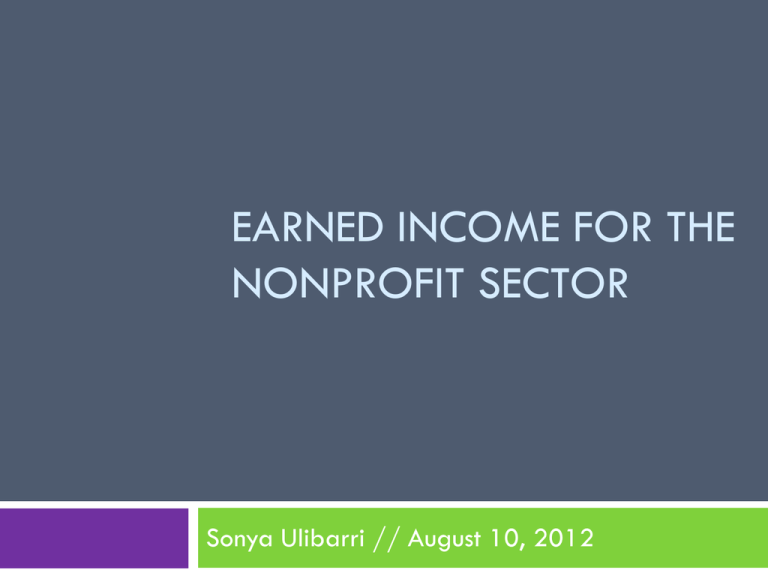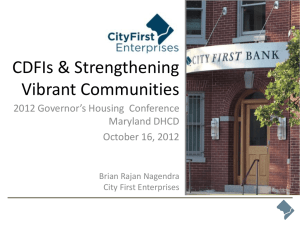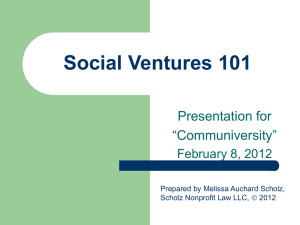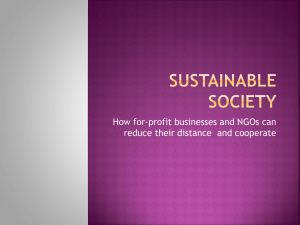Earned Income for the Nonprofit sector
advertisement

EARNED INCOME FOR THE NONPROFIT SECTOR Sonya Ulibarri // August 10, 2012 Earned Income Earned Income: Income earned when there is a direct exchange of product, services, or privilege for money. Earned Income Strategy: An attempt by a nonprofit to cover part of its costs by capitalizing on the earned income potential of its programs, products, or services. * Fact: Approximately 70% of the total income generated by the nonprofit sector in the US ($1.4 trillion) comes through earned income sources. Two Types of Earned Income: 1. 2. Related. Income is tax-exempt. Unrelated. Liable for tax on income. IRS criteria for defining a source as unrelated: A trade or business. Regularly carried on. Not related to furthering the exempt purpose of the organizations. Social Enterprise Social Enterprise: An organization or venture (within an organization) that advances a social mission through marketbased strategies. These strategies include receiving earned income in direct exchange for a product, service, or privilege. *Source: Social Enterprise Alliance History of Social Enterprise in the US Steady growth since the 1970s. Most rapid growth: 1990s to early 2000s (the # of social enterprises quadrupled) Impact of the 2008 Recession still to be seen: Recognized need to diversify resources. Connection between sustainability and the ability to self generate income. Assets decreased, leaving less resources to invest in new strategies. Most organizations (75%) currently operating social enterprises are planning to launch another. Top Five Social Enterprises The top five social enterprises operated by nonprofits in the US are: 1. 2. 3. 4. 5. Education and Training Retail // Thrift Store Consulting Services Food Service // Catering Arts Venue Top Five Missions The top five organizational missions operating social enterprises in the US are: 1. Workforce Development 2. Housing 3. Community & Economic Development 4. Education 5. Health Social Enterprise Revenue % of Revenue from Earned Income Sources by Budget Size 70% 60% 50% 40% 30% 20% 10% 0% $250k and under $5M and over Revenue Indicators The largest indicator of amount of revenue generated by nonprofit social enterprises is length of time the venture has been operating. 80% of organizations who launched prior to 1970 earn on average more than $1 million dollars annually. 80% of organizations who launched after 2000 earn less than $500k annually. Capital for Social Enterprises Top Sources of Capital for Social Enterprises: 1. Foundations. 2. Individual Donors. 3. General Operating // Operating Reserves. * Organizations report (surprise, surprise) that the biggest challenge to launching and growing a social enterprise is: funding. Mission Income WHAT IS THE POTENTIAL & THE PRIORITIES OF YOUR SOCIAL ENTERPRISE? Key Opportunities & Benefits • • • • • • • • • • • Double/Triple Bottom Line (people. planet. profit.) Organizational Sustainability Ability to leverage other funds Leadership Development Internal Investment Public Awareness/Marketing Outreach & Community Engagement Business Savvy Increased Capacity New Allies Professional Development Key Challenges Sales and Marketing Financial Issues Human Relations Operations Organizational Culture * People won’t support the social enterprise solely for mission. If it is both high quality and cost competitive, the mission will be a deciding factor. Group Identified Challenges The following challenges/obstacles/threats were identified by workshop participants: • • • • • • • • Lack of Resources/Other Pressing Needs Lack of Expertise Shift of Power within Organization Top-Down vs. Bottom-Up Approach Change of Expectations Requires Honest Conversations about Money Transparency Accountability: Traditional Constituents or New “Customers” Steps to Launching a Social Enterprise Understanding Motivation (Income or Mission?) Business Plan // Market Research Identification of Start-Up Financing Developing an Operational Plan Outline Potential Scalability Invest in Ongoing Training Business // Impact Plan Articulates Mission. Establishes actions to achieve goals. Outlines performance targets. Projects resources, costs, and revenue. Defines Strategy. Needs of Target Population/Customers Market Conditions State of Industry Operating Environment Questions to Ask 1. 2. 3. 4. How does the organization balance mission and profit and avoid mission-drift? What are the potential challenges and threats to the organization or venture over time? What are the opportunities for growth, larger impact, and long-term sustainability? How will the organizational culture need to change to support a new and different venture? Resources Social Enterprise Alliance www.se-alliance.org











